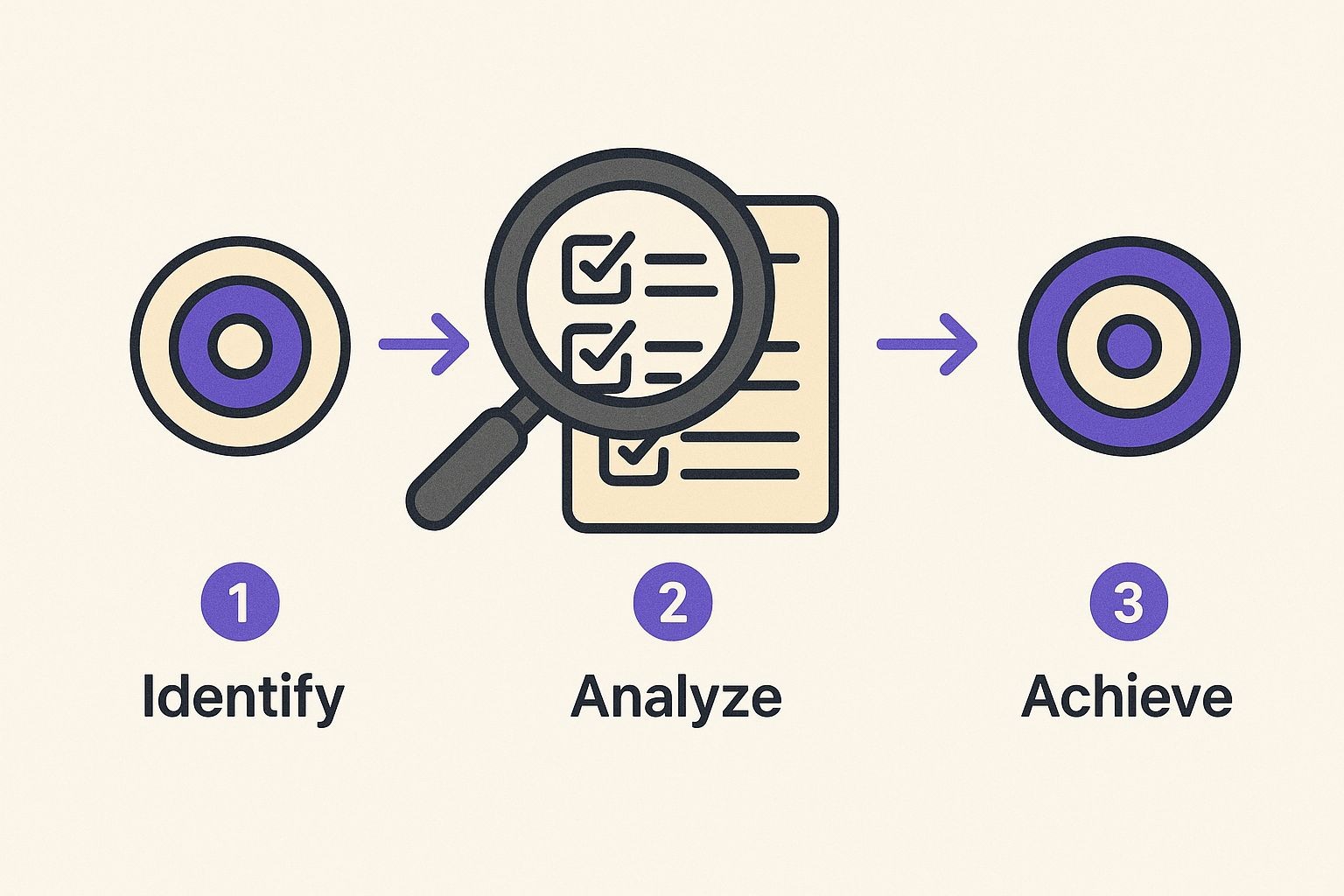A good product launch checklist template is more than just a to-do list; it's your battle plan. It breaks down what feels like a monumental task into small, manageable pieces that everyone on your team can follow. When marketing, engineering, and sales are all reading from the same script, a chaotic launch transforms into a well-orchestrated success.
Why You Need a Pre-Launch Foundation
Ever seen someone try to build a house without a solid foundation? It doesn't end well. The same principle holds true for a product launch. The pre-launch phase is you pouring the concrete. It’s all the unglamorous, behind-the-scenes work that ultimately determines if your product makes a splash or a thud.
This period, which can easily span three to six months, is where the real magic happens. A launch isn't just a single day on the calendar; it's the culmination of hundreds of tiny, coordinated decisions. We’ve seen teams skip this part, and the results are predictable: mixed messages, unprepared teams, and a product that just doesn't land with the right people.
Nailing the pre-launch phase means you’re forced to answer the tough questions early on:
- Who are we actually selling to? This means digging deeper than generic demographics to create customer personas that feel like real people.
- What’s everyone else doing? You need to analyze your competitors, not to copy them, but to spot the gaps they've left wide open.
- What does a "win" look like? Setting clear, measurable goals is the only way to know if you're on the right track.
- What's our story? This is about crafting a value proposition that hits on a genuine pain point for your ideal customer.
Defining Your Ideal Customer and Market Position
Before you can sell a single thing, you have to know exactly who you're talking to. This isn't about broad strokes like age or location. It's about building out detailed customer personas that feel like people you know. What keeps them up at night? What are their career goals? Where do they hang out online?
For instance, if you're launching a new project management tool, one persona might be "Marketing Manager Maria." She’s struggling to juggle ten different campaigns and desperately needs a way to see who on her team is drowning in work. Simple, right?
Once you have Maria in mind, you can look at the competitive landscape through her eyes. What tools is she already using? What drives her crazy about them? This isn't about a feature-for-feature comparison. It’s about finding the weaknesses you can exploit. Maybe the other tools are bloated and complicated, or they don't integrate with her favorite analytics platform. That's your opening.
A well-defined customer persona and a sharp understanding of the competitive landscape are the twin pillars of a strong market position. Without them, your marketing efforts are just shots in the dark.
Setting Clear and Measurable Launch Goals
Okay, so you know who you’re targeting and where you fit in the market. Now what? You need to set goals. And we don’t mean fuzzy objectives like "get our name out there." You need to get specific with SMART goals - Specific, Measurable, Achievable, Relevant, and Time-bound.
A weak goal is "increase brand awareness." A strong goal is: "Achieve 1,000 new user sign-ups and a 5% conversion rate from the landing page within the first 30 days post-launch." See the difference? This gives your team a clear finish line and a way to measure performance. These key performance indicators (KPIs) will be your North Star, guiding every decision you make.
Preparing Your Arsenal of Assets
As you can see, the pre-launch phase is all about laying the groundwork. You’re doing the research, setting the goals, and getting all your materials ready. When you’ve done the hard work of understanding customer pain points and sizing up the competition, you sharpen your product’s positioning.
This clarity makes everything else easier. Your marketing materials - from email templates and social media posts to the sales deck - will practically write themselves. You can use a content calendar to plot everything out, making sure teams are aligned and you aren't scrambling at the last minute. Trust us, this structured approach is what separates a smooth, controlled launch from a chaotic mess.
Here's a quick look at the critical pre-launch tasks and what you're trying to achieve with each.
Pre-Launch Key Action Items
| Task Area | Key Action Items | Primary Goal |
|---|---|---|
| Market Research | Develop detailed customer personas. Conduct thorough competitor analysis. | To deeply understand the target audience and identify market gaps and opportunities. |
| Goal Setting | Define SMART goals and key performance indicators (KPIs) for the launch. | To establish clear, measurable targets for success that guide all launch activities. |
| Positioning | Craft a unique value proposition and core messaging pillars. | To create a compelling narrative that resonates with the target audience and differentiates the product. |
| Asset Creation | Prepare all marketing materials (landing pages, emails, social content, sales decks). | To ensure all necessary assets are ready, on-brand, and organized for a smooth launch day. |
Ultimately, this table summarizes the foundational work that ensures you're not just launching a product, but launching it with purpose and a clear path to success.
This infographic gives you a visual flow of how to build that solid pre-launch foundation, moving from the initial brainstorming all the way to having your assets ready to go.
 What we like about this visualization is how it shows each step building on the last. It really drives home the point that you can't skip ahead; a thorough, sequential process is key.
What we like about this visualization is how it shows each step building on the last. It really drives home the point that you can't skip ahead; a thorough, sequential process is key.
Getting the Green Light: Is Your Product Really Ready?
A killer marketing plan can't save a broken product. Simple as that. Before you even think about your go-to-market strategy, you need a resounding "yes" from your internal teams that the product is stable, secure, and legally good to go. This isn't just about ticking boxes; it’s your last line of defense against a launch day disaster.
Think of it as the final dress rehearsal. This is where engineering, QA, legal, and your support crew all come together to give the final sign-off. Skipping this is like trying to fly a plane after only checking one of the engines - sure, you might get off the ground, but you're asking for trouble.
The Engineering and QA Handshake
The partnership between your engineering and quality assurance (QA) teams is the foundation of a solid product. Your engineers are the ones who sign off on stability, confirming that every feature is built and works as intended. They built it, so they need to be confident it won’t fall apart under real-world pressure.
At the same time, QA’s job is to do their absolute best to break everything the engineers just built. They run rigorous tests, hunting down every bug from tiny visual glitches to those horrible show-stopping crashes. A solid QA process means your first users have a smooth, frustration-free experience from the get-go.
A buggy launch doesn't just make for a bad first impression - it obliterates trust. A customer who hits a wall on day one is highly unlikely to stick around to see if you eventually fix it.
Getting Everyone on the Same Page
Beyond the tech teams, getting that final approval involves a few other key players. Your product doesn’t operate in a silo, and each department brings a critical perspective to the table. Making sure everyone is aligned is a non-negotiable part of any modern product launch checklist template.
This means getting a thumbs-up from a few key departments:
- Legal and Compliance: These folks make sure you’re not about to break any rules, from data privacy laws like GDPR to intellectual property rights. A legal blind spot can turn into a very expensive, very public problem.
- Operations and Support: Is your customer support team actually ready? They need to be trained and armed with documentation to handle the inevitable flood of questions. They’re your front line, so they need to know the product inside and out.
- UX/UI Design: The design team gives one last look to ensure the user interface and overall experience match the vision and, more importantly, are intuitive for someone seeing it for the first time.
This isn't just bureaucratic red tape. A formal readiness checklist forces every department to confirm they're ready, protecting the launch from being derailed by an internal oversight. In fact, research shows that companies with a structured sign-off process can cut their post-launch failure rates by up to 25% and get to market about 15% faster. It’s become a standard for a reason. For a deeper dive, Product School has a great guide on building out these frameworks.
Why You Can't Afford to Rush This
We’ve seen it happen more times than we can count. A team gets nervous about a deadline and pushes to launch with just a "few known issues." It almost never ends well.
In one real-world case, a software company launched a new app without getting that final legal review. Turns out, their data handling was a major violation of privacy regulations in one of their biggest markets. They had to pull the product, issue a public apology, and deal with a massive financial and reputational hit.
Another time, an e-commerce platform rushed to launch, skipping the final stress tests from QA. The moment they got a traffic spike on launch day, the checkout system crashed. And crashed again. They lost thousands in sales and spent the next few weeks trying to win back justifiably angry customers.
The lesson is always the same: any time you think you're "saving" by cutting corners on readiness, you'll pay for it tenfold in damage control later. A patient, thorough approach is always the smarter move.
Crafting Your Go-To-Market Communication Plan
Alright, your product is stable, secure, and ready for the spotlight. Now for the fun part: building some serious momentum. This is where a rock-solid Go-To-Market (GTM) communication plan comes in. It’s far more than just firing off a few emails; it's about making sure your message finds the right people, through the right channels, at the perfect moment.
Think of your GTM plan as the director's script for your launch movie. Every single marketing move - from a cryptic teaser tweet to the big launch day announcement - has a specific part to play. A well-built plan makes sure all these pieces work together, creating a massive wave of excitement instead of a few disconnected ripples.

Mapping Your Promotional Calendar
First thing's first: get a promotional calendar on the books. This isn't just a nice-to-have; it's the centerpiece of your entire communication strategy. It’s a visual timeline that maps out every single marketing touchpoint before, during, and after you go live. This simple tool forces you to think sequentially and stops any channel from becoming an afterthought.
The best way to tackle this is to work backward from your launch date. Let’s say you’re launching on the 30th. What needs to happen on the 29th? What about the week leading up to it? This simple shift in perspective helps you layer your activities for the biggest possible impact.
A rough outline might look something like this:
- Four weeks out: Start dropping hints on social media. Talk about the problem your product solves, but don't give away the solution just yet.
- Two weeks out: Announce the official launch date. Fire up an email countdown for anyone on your waitlist.
- One week out: Publish a blog post that goes deep into the "why" behind your new product. Tell the story.
- Launch day: It's go-time. Coordinate a full-court press across every channel - email, social media, PR, and your website.
Suddenly, your marketing efforts aren't just random acts. They're a deliberate, strategic campaign.
Orchestrating Your Channels
A modern product launch happens everywhere at once. Your ideal customer might see a LinkedIn post from an influencer, get an email from your list, and read a press mention all before their morning coffee is finished. Your job is to orchestrate all these channels so they sing in harmony, reinforcing one single, powerful message.
This means you have to tailor your content for each platform. A super-detailed technical breakdown? Perfect for a blog post. A quick, high-energy demo video? That’s made for Instagram Reels or TikTok. The goal is consistency in messaging, not uniformity in format.
We see this mistake all the time: teams just cross-post the exact same content everywhere. A winning launch plan respects the unique context and audience of each platform, tweaking the core message so it feels native and natural wherever it appears.
For launch day itself, you could sequence your communications like this: send an email blast at sunrise to your most loyal subscribers, follow it up with a coordinated social media push during peak engagement hours, and then spend the afternoon amplifying any early press coverage you get. Each action builds on the last, creating an undeniable sense of buzz.
Driving Engagement with Event-Based Marketing
Want to generate real-time excitement? Host an event. Things like a launch day webinar, a live Q&A with the founders, or an expert panel discussion create a focal point for your launch. They give you a chance to capture your audience's undivided attention, creating a sense of urgency and community that a static blog post just can't match.
Of course, the trick is getting people to actually show up. This is where a simple tool can make a world of difference. For instance, our service, Add to Calendar PRO, lets you embed simple "Add to Calendar" buttons right on your landing pages and in your promotional emails. When someone clicks it, the event is saved straight to their personal calendar - be it Google, Outlook, Apple, you name it.
This tiny action can massively boost your attendance rates. It closes the all-important gap between someone being interested in your launch event and them actually remembering to join when you go live. For a deeper dive, check out our guide on building an effective event marketing plan. This small detail is a huge part of turning passive interest into active participation - which is exactly what a great GTM plan is all about.
Executing a Seamless Launch Day
All those late-night strategy sessions and meticulous planning have led you here. Launch day is when your preparation finally meets the market. Getting it right is less about a single "big bang" moment and more about a series of perfectly timed, coordinated moves.

The morning of the launch isn't for big strategic shifts; it's for final checks. Before your first announcement even thinks about going live, the tech team needs to run through one last pre-flight checklist. This is your chance to confirm everything is humming - servers are stable, tracking pixels are firing, and the new product page loads like a dream. Trust us, a tiny glitch like a broken checkout link can completely torpedo your momentum.
Coordinating the Communications Rollout
Once you get the all-clear from tech, it’s time to hit "go" on your communications plan. This is the moment you've been building toward with your promotional calendar, and the sequence of events is everything. A great place to start is with your email list. These are your most loyal followers, and they absolutely deserve to hear the news from you first.
Next, it's time to light up your social media channels. Push those pre-scheduled posts live and make sure your team is on standby, ready to jump into comments and questions in real-time. That immediate back-and-forth creates a powerful sense of community and shows everyone you’re listening from minute one. At the same time, your PR team should be hitting up their press contacts with the official release, aiming for coverage you can share and amplify all day long.
Launch day is really just an exercise in controlled execution. You're trying to create a wave of synchronized activity across every channel, making your launch feel like an unmissable event, not just a quiet update.
Establishing Your Launch War Room
To keep all this moving smoothly, you need a central command center - a "war room." This doesn't have to be a physical room filled with whiteboards, especially for remote teams. A dedicated Slack channel or a persistent video call works just as well. The whole point is to create one single space where every key stakeholder can communicate instantly.
This kind of centralized hub makes rapid decision-making possible. If a customer tweets about a bug, the social media manager can flag it for engineering right away. When a big publication covers your launch, the PR lead can drop the link for everyone to amplify. It's this constant, free-flowing information that lets you pounce on opportunities and squash problems before they grow.
Monitoring Feedback and KPIs in Real Time
With your communications out in the wild, the focus shifts to monitoring. You need a dedicated person or team tracking real-time feedback and your initial key performance indicators (KPIs). This is about more than just watching the sales numbers go up; it's about getting an immediate read on how the market is reacting.
Here’s what your monitoring team should have their eyes on:
- Social Media Sentiment: Are people excited? Confused? Frustrated? Tools can help you track mentions and overall sentiment, giving you a quick pulse check.
- Initial KPIs: Keep a close watch on website traffic, sign-up rates, and early conversion numbers. Compare them against the goals you set - these are the first signs of whether your message is hitting home.
- Support Channels: Monitor incoming support tickets and live chat like a hawk. Early questions often point to gaps in your onboarding or FAQ docs that you can patch up on the fly.
By staying on top of these things, you can spot and fix any surprise issues quickly, making sure that minor hiccups don't turn into major roadblocks that kill your hard-earned launch day momentum.
Sustaining Momentum After the Launch
The launch day champagne has been popped and the initial buzz is starting to die down. It’s a classic mistake to think the hard work is done. In reality, it’s just getting started. A product launch isn't the finish line; it’s the starting gun for the real race: sustained growth.
This is where you pivot from creating hype to building real, lasting relationships with your customers. The post-launch phase is all about turning that first wave of interest into loyalty. You'll be using actual data and feedback to figure out what comes next. Skipping this part is the fastest way to let a great launch just... fizzle out.
Analyzing Performance and Gathering Feedback
First thing's first: dive into the data. Remember those SMART goals you hammered out in the pre-launch phase? Time to see how you did. Crack open your analytics and see how your actual performance stacks up against the key performance indicators (KPIs) you set.
And please, look past the vanity metrics. A big spike in website traffic looks great, but how many of those visitors actually started a trial? What was the conversion rate on your shiny new product page? These are the numbers that tell the real story.
While the numbers tell you what happened, you need qualitative feedback to understand why. This is your moment to listen - really listen - to your first users. They are your single most valuable source of insight right now.
- User Surveys: Fire off some simple, targeted surveys to new customers. Ask them about their first-run experience, what they love, and what left them scratching their head.
- Support Tickets: Your support team is on the front lines. Dig into those tickets to find recurring problems or common questions. These are big red flags pointing to friction in your user experience.
- Social Listening: Keep an eye on social media for the candid, unfiltered opinions. People often share their honest thoughts - good and bad - which can be incredibly insightful.
The post-launch period is less about broadcasting and more about listening. The feedback you collect in these first 30 days is a goldmine that will shape your product roadmap for the next year.
Nurturing Your First Wave of Customers
Your early adopters aren't just your first sale. They're the founding members of your community. How you treat them now sets the tone for your brand's reputation for years to come. Make them feel important.
Celebrate the small wins with them. Did you hit your first 100 users? Share that! This kind of transparency creates a shared sense of journey and makes your customers feel like they're part of your success.
Engaging this initial group is absolutely critical for building momentum. You might even create an exclusive community for them, like a private Slack channel or a dedicated forum. This gives them a direct line to your team and a place to connect with other early fans. For more on keeping your community fired up, check out our article on event promotion ideas; many of those strategies can be tweaked for post-launch community building.
Planning Your Next Move
The final piece of the post-launch puzzle is using all this newfound knowledge to plan what's next. Your product is no longer just something you built; it's a living thing that will grow and change based on what your users actually need.
Gather up all the feedback - from surveys, support tickets, social media, and one-on-one chats - and use it to prioritize your next product update. Is there a specific feature request that keeps popping up? Are users constantly getting tripped up in one part of the onboarding? This data-driven approach means you're not just guessing; you're building what customers are already asking for.
This is the point where you officially shift from a "launch" mindset to one of continuous improvement. The goal is no longer just getting the product out there. It's about consistently delivering value that keeps customers around and turns them into your biggest advocates. That sustained effort is what turns a good launch into a great business.
Product Launch Frequently Asked Questions
Even with a rock-solid checklist, questions always pop up. Let's tackle some of the most common ones we hear from product managers and marketers to help you iron out the wrinkles in your own launch process.
How Far in Advance Should I Start Using a Product Launch Checklist?
For most software or digital products, you'll want to start digging into your checklist three to six months before the big day. That's usually the sweet spot for doing your homework - like solid market research, defining your audience, and creating marketing materials that don't feel rushed.
But that's not a hard-and-fast rule. If you're wading into more complex waters, like launching a physical product with a whole manufacturing chain or breaking into a new international market, you should give yourself a much longer runway. Think nine to twelve months. Starting that early gives you a vital buffer for those inevitable, "oops, that broke" moments and lets your team pivot based on real feedback.
What Are the Most Commonly Overlooked Items on a Launch Checklist?
It's almost always the less glamorous tasks that get missed when teams are moving fast. One of the biggest offenders is internal team training. Your sales and customer support folks need to be the ultimate experts on the new product before it's live. If they're not, those critical first customer conversations are going to be painful.
Another one that gets pushed to the last minute is setting up analytics and tracking correctly. You have to get this done well ahead of time to make sure you're capturing clean, trustworthy data from the very first click. A third classic oversight is the lack of a detailed post-launch communication plan for those first 30 days. It's a huge reason why so many launches lose their initial sizzle.
A launch doesn't end when you hit "publish." The real work begins right after, with analyzing early data, celebrating wins with your first customers, and planning that first update. That's what turns a flash in the pan into long-term growth.
How Can I Adapt a Template for My Specific Product?
A generic template is just a starting point; the real magic is in the customization. First, add or delete entire sections based on what you're actually building. A hardware launch needs steps for manufacturing and supply chains, which a SaaS product obviously won't.
Next, get real about your team's size and resources and adjust the timelines accordingly. Then, and this is non-negotiable, assign a single, specific owner to every single task on that list. Ambiguity is where execution goes to die. Finally, weave your team's actual tools into the checklist. Instead of a vague "track bugs," make it "Create Jira ticket for all launch-blocking bugs." That's how a template becomes an operational plan.
What Is the Difference Between a Launch Checklist and a GTM Strategy?
Great question, as this one trips up a lot of people. The easiest way to think about it is like building a house:
- The Go-To-Market (GTM) Strategy is your architectural blueprint. It's the high-level plan that answers the "what" and "why." It defines your target audience, your unique value proposition, and how you'll price and position the product.
- The Product Launch Checklist is the detailed construction schedule. It's the tactical, ground-level tool that lays out the "how," "who," and "when." It takes that big GTM strategy and breaks it down into a sequence of concrete tasks with owners and deadlines.
Simply put, your GTM strategy is the map, and the checklist is the turn-by-turn directions. You absolutely need both to get where you're going.
For any launch involving webinars or live demos, knowing who's showing up is critical. A reliable system for event attendance tracking gives you priceless data that feeds right back into your GTM strategy and post-launch analysis. You can dive deeper in our guide on effective strategies for tracking event attendance.
At Add to Calendar PRO, we're obsessed with making sure your audience never misses an important date. Our simple, customizable "Add to Calendar" buttons plug right into your launch emails and landing pages, helping you pack the house for your webinars and live events. Start your free trial today and see how easy it is to turn sign-ups into attendees.



